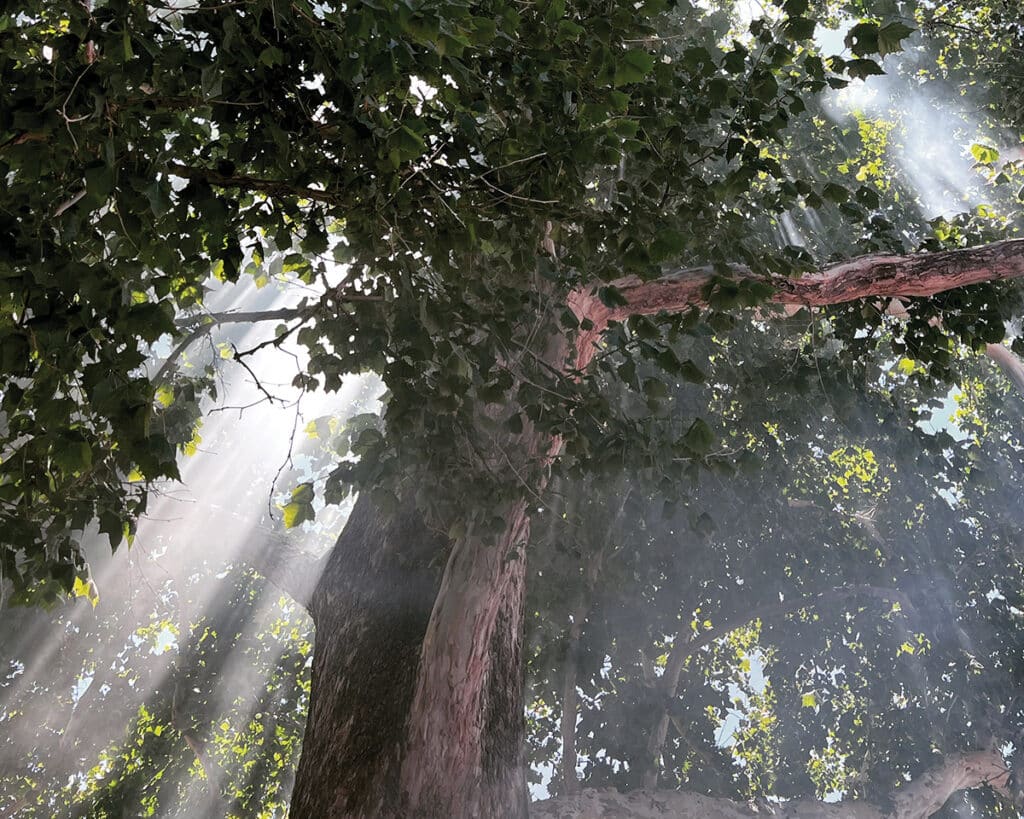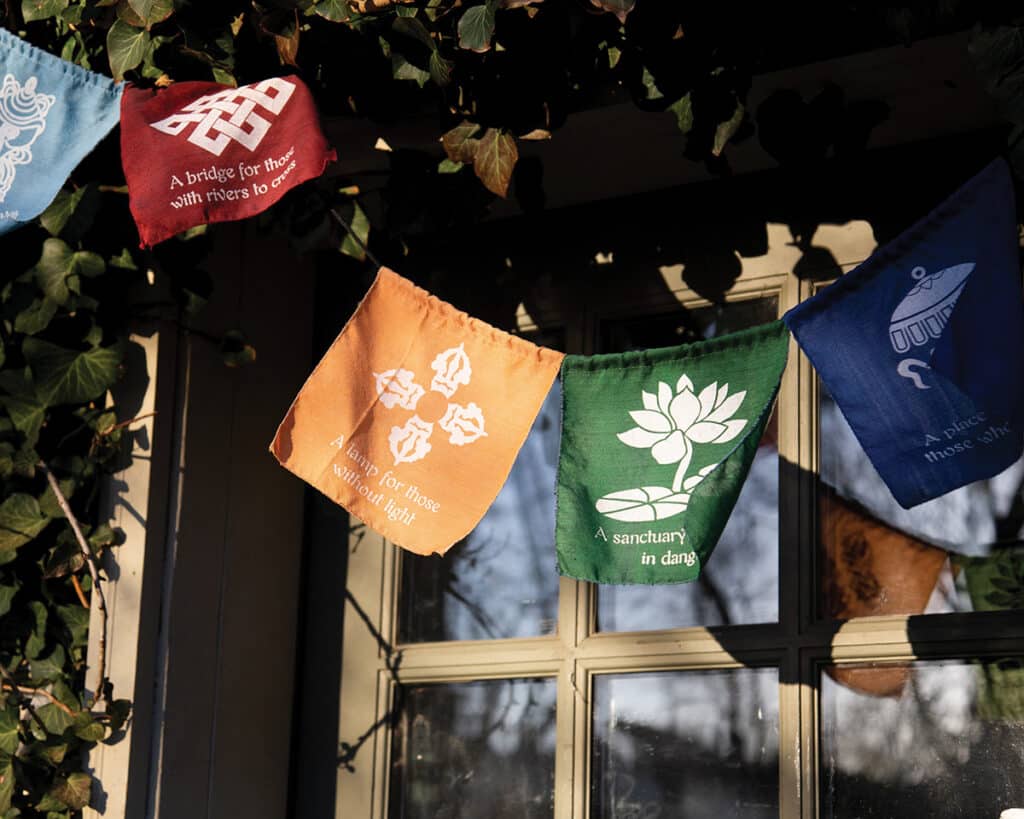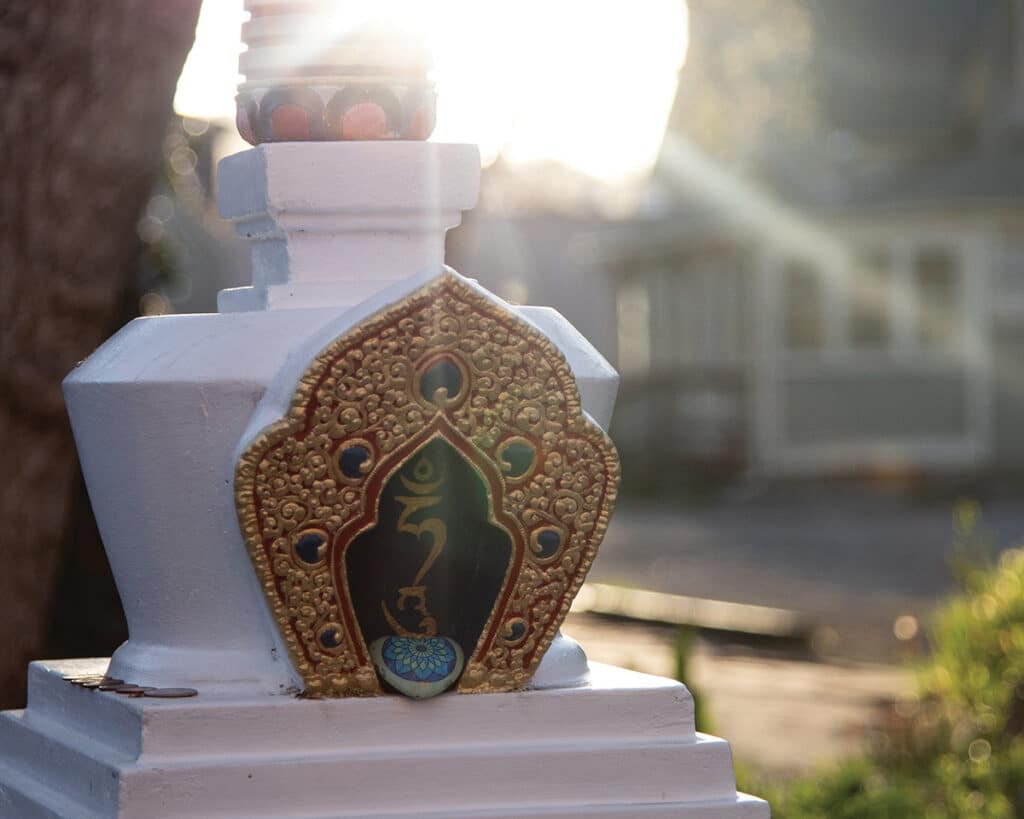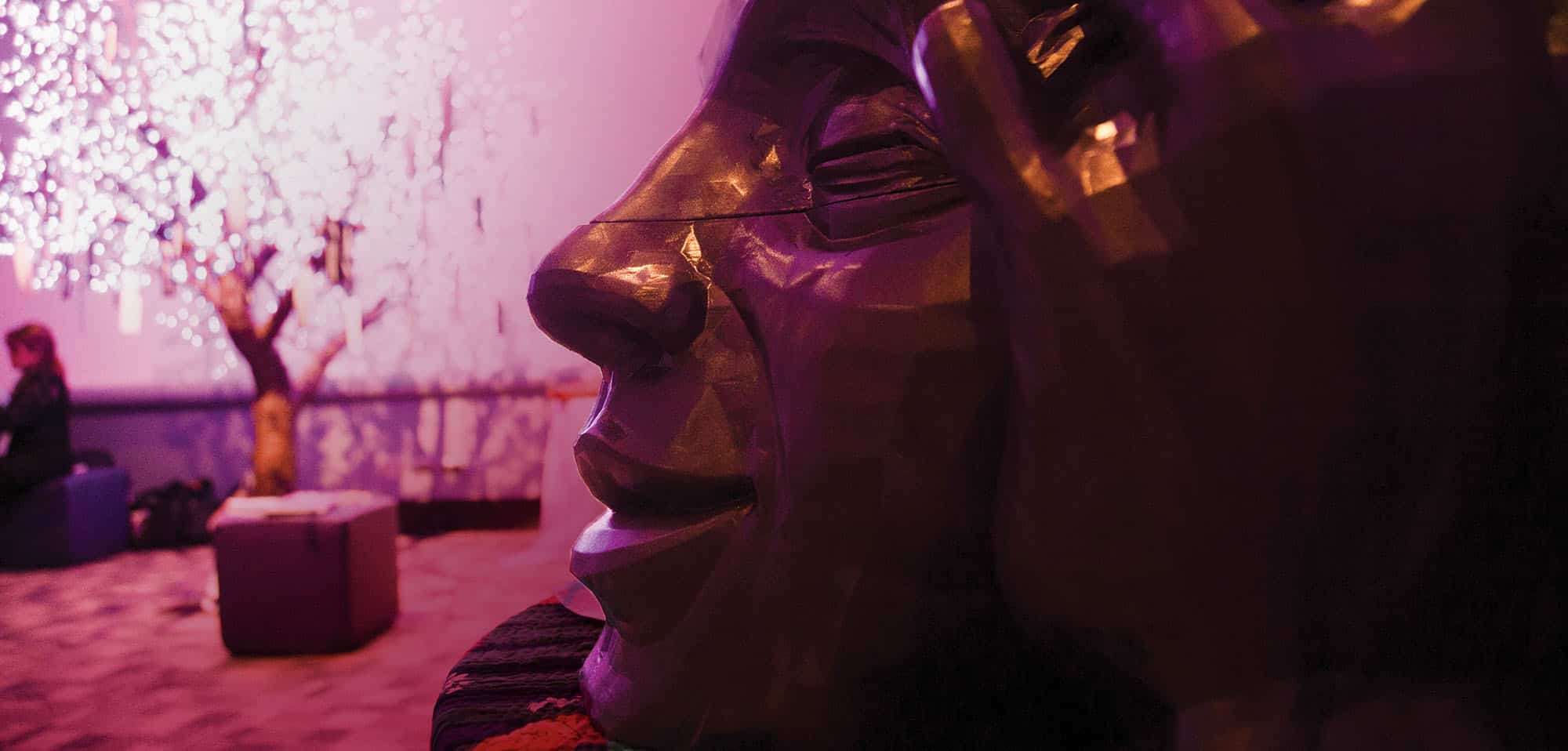As a professor of Buddhist Studies at Naropa, I have the permission and expectation to be outrageous, which is one of the benefits of teaching at this university. As Naropa is approaching its 50th anniversary, I am taking the opportunity to engage in some disruptive, outer-inner-cosmic academic reflection on my experiences and the history of this institution. In 1998, I responded to a classified ad in the Boulder Daily Camera for an administrative position at the university. I exchanged Monty Python quotes with the interviewer and was hired on the spot. On my first day, I walked into the main red brick building on the Arapahoe campus and glanced up at a photo of an Asian man in a grey suit with a cheeky look on his face. At that moment, I felt a strange sensation, like time and space had slipped away, and I heard a trilling, high-pitched giggle. I wondered if the man in the photo was laughing at me. Suddenly, the moment shifted back to conventional time, but I knew then that the place had ancient magic.
The outer-level emergence of Naropa is well-documented. In the summer of 1974, the Institute offered its first two summer sessions in an old bus depot in Boulder, Colorado. It was a time of sweeping political and social change, and the gathering was a response to exploring unconventional ways of being in the world. America was ripe for spiritual traditions such as Buddhism to advance. In many ways, Asian spirituality provided a more thorough contrast to the rejected individualism of the time. To external achievement, it posed inner experience; to the exploitation of nature: harmony with the whole of existence.
Further, the arrival of Tibetan Buddhism in the United States coincided with the emergence of a counterculture characterized by social, political, and spiritual upheaval. Tibetan Buddhist leaders arrived in the 1960s and 70s from a very religiously conservative society. They found themselves adapting their practice methods to meet the needs and ideas of Westerners, who mostly rejected the conventions of their own society. Initially, the path of Buddhism in America was shaped by individuals who were fundamentally alienated from mainstream American ways of life.

In addition to the external circumstances surrounding the founding of the university, a more profound emergence is at play. On an inner and cosmic level—conventions that are part of the Tibetan tradition—Naropa University has the characteristics of gnas (pronounced ‘ney,’), a Tibetan word translated as a “holy place, abode, dwelling, source, foundation, locale, a repository of the divine.” But this word is also a verb meaning to exist, to be, to reside, to stay, to dwell, or to abide. Further, it can designate the abodes of deities and spirits in their respective states of being, prevailing on their own terms in their own space. Understanding this term and its Tibetan usage requires fluidity regarding the concepts of location, existence, and pervasiveness. Gnas refract innate powers; they are spaces where one can cultivate a sheer, pure experience; they activate processes perceived to be occurring naturally. They are places of holistic confluence.
It was then that I discovered that Chögyam Trungpa was a treasure revealer responsible for introducing many innovative and radical teachings and practices.
For a Tantric Buddhist practitioner, called a tāntrika, the naturally occurring qualities of gnas are recognized and employed to achieve enlightenment. Additionally, treasures can be hidden in such places. In Tibetan, gter ma (pronounced terma) refers to various religiously significant objects, texts, teachings, dances, songs, practices, temple design, and sacred intentions, mainly associated with the eighth-century tantric Buddhist wizard, Padmasambhava, who hid physical treasures in the Tibetan landscape and sacred teachings and intentions within the mind-streams of certain exceptional beings. These would remain hidden until an apt person—called a gter ston or treasure revealer, retrieved them at an advantageous future date.
Treasure in the Tibetan tradition can be broadly classified into three types—earth treasures, mind treasures, and pure vision treasures. The classification of these treasures depends on the nature and source of their discovery. Earth treasures are archaeological discoveries of texts or objects in natural phenomena such as rocks, caves, walls, trees, or lakes. These texts are usually fragmentary, written in symbolic scripts, and on yellow paper scrolls. Mind treasures, on the other hand, are teachings revealed through visions. The treasures are revealed in the minds of the revealers, who write them down, sometimes in coded scripts, later translated into an ordinary readable language. During the revelation, the treasure revealers may see letters appearing in the sky or receive coded messages from mysterious figures visible only to them. Pure vision treasures are difficult to define and are revealed by highly advanced teachers with a heightened understanding of reality. These treasures emerge as enlightened teachings that take many forms.
I wrote my doctoral thesis on the terma tradition and traced its trajectory from ancient times to the present. After completing my studies, a series of fortunate events led me back to Naropa, where I became a professor in the Wisdom Traditions department in 2015. It was then that I discovered that Chögyam Trungpa was a treasure revealer responsible for introducing many innovative and radical teachings and practices. In Tibetan Buddhism, a treasure revealer is an innovation agent who acts as an intermediary for sentient beings, ensuring that the Buddhist doctrine is preserved and the lineage blessings do not fade. Treasures in Tibetan Buddhism transcend cultural, geographic, temporal, and even societal boundaries, and they provide a way for other cultures to benefit from the direct transmission of teachings relevant to their par ticular circumstances. The success of a treasure’s revelation depends on all the necessary auspicious conditions coming together.

In the Tibetan tradition, treasure revealers are often considered controversial figures due to their unconventionality. They are sometimes societally unsavory. Chögyam Trungpa, in this sense, was certainly beyond any kind of ordinary scope; he was a traumatized refugee, a brilliant scholar and powerful teacher, an alcoholic, a father, a husband, and a womanizer; these are hard to reconcile, because he was all those things simultaneously. Although we cannot excuse or condone any documented stories of harmful behavior, it is essential to note that to me, as a scholar of this tradition, his complicated and messy legacy is unsurprising because he came from a tradition and culture, a spiritual path, that holds paradox in a nuanced way. It is also clear to me that we must wisely and compassionately grapple with his legacy as an institution in our time and place. Particularly in the last few years, with greater awareness given to historic and more recent incidents of sexual abuse, assault, and misconduct—coupled with the bravery of victims speaking out—we have all had to acknowledge and work through the errors and mistakes of previous generations, mistakes we do not want to repeat. This article isn’t intended to solve the complex legacy problem. That requires time, space, and conversation.
I stand with all victims and condemn unethical behavior that causes suffering to any sentient being. The next generation of professors at Naropa intends to hold our legacy wisely and take Naropa forward without ignoring its past. To address this issue, I have included a section on sexual misconduct in Buddhist communities in one of my courses, Buddhism and Modernity, at Naropa. I encourage my students to have brave and honest conversations and dialogues, so that we can heal and move forward together. This journey can be challenging, but we’re committed to it.
From the Tibetan tradition's perspective, Naropa University is one lamp among a long line of butter lamps. It is a place of chaotic and profound wisdom, better known as crazy wisdom or primordial wisdom, unbound.
Much of Chögyam Trungpa’s ‘dharmic’ innovations, such as his terma text the Sādhana of Mahāmudrā and his radical expression of the Shambhala myth, provide a template for developments of hybrid Buddhist psychological practice and arguably represent a kind of American neo-terma, in that they appear to be the first example of Tibetan Buddhist treasure revealed in the West, adapted to a Western setting and audience. Trungpa’s Shambhala texts and sadhana are considered treasures by his followers and recognized by the esteemed master, Dilgo Khyentse Rinpoche (c. 1910–1991). Senior students and members of the Nalanda Translation Committee described broaching the subject of terma revelation with Chögyam Trungpa Rinpoche in the late 1970s:
“In 1978, during a Nalanda Translation committee session, Trungpa was asked whether the Shambhala texts he was presenting were terma… he replied, “Yes, sort of.” When we asked whether we should include the terma mark to indicate terma in our translations, his response was, “Not yet, maybe later.” In fact, this did not come to pass until after his death, when Dilgo Khyentse Rinpoche instructed us to include this in our future publications of these texts, and he confirmed with no hesitation that they were indeed authentic terma.
I understand that I am not authorized to make any official declarations. Still, I have concluded that Naropa University is a gnas, meaning it is a sacred place and a place of terma, a hidden treasure. However, the definition of treasure in this context differs from what we typically think. It is not about a chest of rubies, a pile of gold coins, or a pirate captain’s booty.

We should view sacred spaces as places to wake up and shake things up. They are powered by profound and transformative ancient magic. However, it’s important to note that these spaces are not always nice. They can be messy and bring out the best and worst in us in absurdly profound ways, both outer, inner, and cosmic. Treasure revealers and their treasures represent a form of ‘close transmission,’ which keeps a connection to the lineage holders. This connection is similar to a line of butter lamps, where each lamp lights the next, and so on. It provides a distinct link between the past, present, and future and ensures that the teachings are constantly refreshed and can continue. Naropa University has a close transmission back to the Indian Buddhist Mahāsiddhas and the other holy lineages of Tibet, particularly the Nyingma and Kagyü schools. This connection also extends to the Tibetan people, who have cherished and nourished the wisdom of the Buddha’s dharma for over 1,000 years. Despite immense adversity, they kept the light burning so it could be kindled here for us.
In this way, Naropa University is not centered around any one person. From the Tibetan tradition’s perspective, Naropa University is one lamp among a long line of butter lamps. It is a place of chaotic and profound wisdom, better known as crazy wisdom or primordial wisdom, unbound. This wisdom evolves when one chooses to remain focused on the sorrows and injustices of the world yet insists on espousing joy despite everything. It is equally brave and kind, embracing risk and turning the tables on neurosis, transforming it. Naropa University is a jewel that we all treasure dearly. Staff, faculty, and students are here because we have connected to this source of wisdom like hundreds of little Bluetooth speakers. When we cross the campus boundary, we know we are entering a sacred space that holds the treasure revealed for our time and place, even if it is messy and complicated. We have a sacred duty to protect it and keep the lamp lit.





